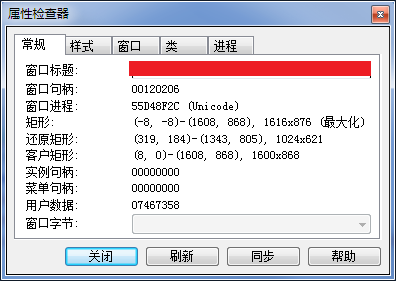在QT中如果想要自绘标题和边框,一般步骤是:
1) 在创建窗口前设置Qt::FramelessWindowHint标志,设置该标志后会创建一个无标题、无边框的窗口。
2)在客户区域的顶部创建一个自绘标题栏。
3)给窗口绘制一个背景作为边框。
4)如果想要鼠标拖动效果,可以在WM_NCHITTEST消息中返回HTCAPTION,具体方法百度这里不再详述。
但是这样做会导致一个问题:
在win7系统上,将窗口移动到屏幕边缘会自动排列(在屏幕顶部,左边,右边都会自动排列)的功能失效。
如果你的窗口没有这个功能,只有两种可能:
1)你的窗口不支持"移动到屏幕边缘自动排列"功能。
2)你从系统关闭了此项功能(控制面板轻松访问轻松访问中心使任务更容易被关注防止将窗口移动到屏幕边缘时自动排列窗口)。
怎么样才能够既能够自绘标题和边框,又能够使用屏幕自动排列功能:
有一个windows消息能够帮助我们,响应WM_NCCALCSIZE消息,直接返回true,就可以使客户区域的大小和窗口大小完全一样,这样就没有了标题栏和边框,我们可以按照上面的一般步骤来自绘标题栏和边框,唯一不同的是不需要设置Qt::FramelessWindowHint标志。
这样做也会有问题:
窗口显示的不完整,特别是在最大化的时候,非常明显。
为什么会显示不完整,这个问题困扰我一整天。我新建了一个win32项目,响应WM_NCCALCSIZE消息,窗口显示完整,应该是QT自己处理的问题,最后不断调试QT源码,终于明白问题所在:
调用堆栈(从下往上看):
QWindowsWindow::frameMarginsDp() 行 1854 C++ QWindowsWindow::frameMargins() 行 188 C++ QWidgetPrivate::updateFrameStrut() 行 11824 C++ QWidget::create(unsigned int window, bool initializeWindow, bool destroyOldWindow) 行 1358 C++
关键函数:
QMargins QWindowsWindow::frameMarginsDp() const { // Frames are invalidated by style changes (window state, flags). // As they are also required for geometry calculations in resize // event sequences, introduce a dirty flag mechanism to be able // to cache results. if (testFlag(FrameDirty)) { // Always skip calculating style-dependent margins for windows claimed to be frameless. // This allows users to remove the margins by handling WM_NCCALCSIZE with WS_THICKFRAME set // to ensure Areo snap still works (QTBUG-40578). m_data.frame = window()->flags() & Qt::FramelessWindowHint ? QMargins(0, 0, 0, 0) : QWindowsGeometryHint::frame(style(), exStyle()); clearFlag(FrameDirty); } return m_data.frame + m_data.customMargins; }
注释里面清楚说明这是一个BUG(QTBUG-40578),我们虽然已经让客户区域大小和窗口大小完全一样,但是QT还是认为系统有边框,只有当设置了Qt::FramelessWindowHint标志,才会返回QMargins(0, 0, 0, 0)。
现在又回到了原点,且问题相互矛盾,想要自绘标题和边框必须设置Qt::FramelessWindowHint标志,但是设置Qt::FramelessWindowHint标志后"屏幕边缘自动排列"无效。
首先要搞清楚Qt::FramelessWindowHint标志如何影响窗口,因为它直接导致"屏幕边缘自动排列"无效:
WindowCreationData::fromWindow(const QWindow * w, const QFlags<enum Qt::WindowType> flagsIn, unsigned int creationFlags) 行 519 C++ QWindowsWindowData::create(const QWindow * w, const QWindowsWindowData & parameters, const QString & title) 行 1075 C++ QWindowsIntegration::createWindowData(QWindow * window) 行 316 C++ QWindowsIntegration::createPlatformWindow(QWindow * window) 行 340 C++ QWindowPrivate::create(bool recursive) 行 392 C++ QWindow::create() 行 549 C++ QWidgetPrivate::create_sys(unsigned int window, bool initializeWindow, bool destroyOldWindow) 行 1456 C++ QWidget::create(unsigned int window, bool initializeWindow, bool destroyOldWindow) 行 1321 C++ QWidgetPrivate::createWinId(unsigned int winid) 行 2528 C++
void WindowCreationData::fromWindow(const QWindow *w, const Qt::WindowFlags flagsIn, unsigned creationFlags) { if (popup || (type == Qt::ToolTip) || (type == Qt::SplashScreen)) { style = WS_POPUP; } else if (topLevel && !desktop) { if (flags & Qt::FramelessWindowHint) style = WS_POPUP; // no border else if (flags & Qt::WindowTitleHint) style = WS_OVERLAPPED; else style = 0; } else { style = WS_CHILD; } if (!desktop) { if (topLevel) { if ((type == Qt::Window || dialog || tool)) { if (!(flags & Qt::FramelessWindowHint)) { style |= WS_POPUP; if (flags & Qt::MSWindowsFixedSizeDialogHint) { style |= WS_DLGFRAME; } else { style |= WS_THICKFRAME; } if (flags & Qt::WindowTitleHint) style |= WS_CAPTION; // Contains WS_DLGFRAME } } else { exStyle |= WS_EX_TOOLWINDOW; } } } }
上面一个是调用堆栈(从下往上看),一个是关键函数(函数中不重要的内容已经删除)。从代码中可以看出,设置Qt::FramelessWindowHint标志会改变窗口样式,从而影响创建的窗口,现在基本已经知道,"屏幕边缘自动排列"功能与窗口样式有关。
新建一个win32窗口程序,不断改变窗口的样式,最后得出结论:只有在窗口拥有WS_MAXIMIZEBOX | WS_THICKFRAME样式时,"屏幕边缘自动排列"功能才有效,最好还要添加WS_CAPTION样式,否则窗口最大化会覆盖任务栏。
原本以为完美结束了,但是不要高兴的太早,经过不断测试,还有几个问题:
1)在任务栏点击窗口时,不能最小化:
只要加上Qt::WindowMinimizeButtonHint标志即可解决该问题。
2)如果有多个显示器,在辅屏上直接显示最大化,窗口显示不完整:
QWindowsWindow::show_sys() 行 1230 C++ QWindowsWindow::setVisible(bool visible) 行 1092 C++ QWindow::setVisible(bool visible) 行 518 C++ QWidgetPrivate::show_sys() 行 7897 C++ QWidgetPrivate::show_helper() 行 7826 C++ QWidget::setVisible(bool visible) 行 8110 C++ QWidget::showMaximized() 行 3154 C++
void QWindowsWindow::show_sys() const { int sm = SW_SHOWNORMAL; bool fakedMaximize = false; const QWindow *w = window(); const Qt::WindowFlags flags = w->flags(); const Qt::WindowType type = w->type(); if (w->isTopLevel()) { const Qt::WindowState state = w->windowState(); if (state & Qt::WindowMinimized) { sm = SW_SHOWMINIMIZED; if (!isVisible()) sm = SW_SHOWMINNOACTIVE; } else { updateTransientParent(); if (state & Qt::WindowMaximized) { sm = SW_SHOWMAXIMIZED; // Windows will not behave correctly when we try to maximize a window which does not // have minimize nor maximize buttons in the window frame. Windows would then ignore // non-available geometry, and rather maximize the widget to the full screen, minus the // window frame (caption). So, we do a trick here, by adding a maximize button before // maximizing the widget, and then remove the maximize button afterwards. if (flags & Qt::WindowTitleHint && !(flags & (Qt::WindowMinMaxButtonsHint | Qt::FramelessWindowHint))) { fakedMaximize = TRUE; setStyle(style() | WS_MAXIMIZEBOX); } } // Qt::WindowMaximized } // !Qt::WindowMinimized } if (type == Qt::Popup || type == Qt::ToolTip || type == Qt::Tool || testShowWithoutActivating(w)) sm = SW_SHOWNOACTIVATE; if (w->windowState() & Qt::WindowMaximized) setFlag(WithinMaximize); // QTBUG-8361 ShowWindow(m_data.hwnd, sm); clearFlag(WithinMaximize); if (fakedMaximize) { setStyle(style() & ~WS_MAXIMIZEBOX); SetWindowPos(m_data.hwnd, 0, 0, 0, 0, 0, SWP_NOACTIVATE | SWP_NOMOVE | SWP_NOSIZE | SWP_NOZORDER | SWP_NOOWNERZORDER | SWP_FRAMECHANGED); } }
还是老样子,上面一个是调用堆栈,一个是关键函数,我们可以看到最后QT调用了ShowWindow函数来显示最大化窗口,但是为什么会显示不完整呢?
通常遇到一个复杂的问题,我会新建一个简单的项目来做实验。新建一个win32项目,最开始显示就让它最大化,结果显示正常,证明还是QT自己处理的问题,应该是在ShowWindow之后进行其他的处理,导致窗口显示不完整,最后发现是
处理WM_GETMINMAXINFO消息导致的,接下来我们看看QT如何处理WM_GETMINMAXINFO消息。
QWindowsWindow::getSizeHints(tagMINMAXINFO * mmi) 行 2044 C++ QWindowsContext::windowsProc 行 1015 C++ qWindowsWndProc(HWND__ * hwnd, unsigned int message, unsigned int wParam, long lParam) 行 1271 C++
void QWindowsWindow::getSizeHints(MINMAXINFO *mmi) const { const QWindowsGeometryHint hint(window(), m_data.customMargins); hint.applyToMinMaxInfo(m_data.hwnd, mmi); if ((testFlag(WithinMaximize) || (window()->windowState() == Qt::WindowMinimized)) && (m_data.flags & Qt::FramelessWindowHint)) { // This block fixes QTBUG-8361: Frameless windows shouldn't cover the // taskbar when maximized const QScreen *screen = window()->screen(); // Documentation of MINMAXINFO states that it will only work for the primary screen if (screen && screen == QGuiApplication::primaryScreen()) { mmi->ptMaxSize.y = screen->availableGeometry().height(); // Width, because you can have the taskbar on the sides too. mmi->ptMaxSize.x = screen->availableGeometry().width(); // If you have the taskbar on top, or on the left you don't want it at (0,0): mmi->ptMaxPosition.x = screen->availableGeometry().x(); mmi->ptMaxPosition.y = screen->availableGeometry().y(); } else if (!screen){ qWarning() << "window()->screen() returned a null screen"; } } qCDebug(lcQpaWindows) << __FUNCTION__ << window() << *mmi; }
当程序在辅屏上时,它的screen是辅屏,如果当前screen不等于QGuiApplication::primaryScreen(主屏),则不设置MINMAXINFO结构,但是由于它已经处理了WM_GETMINMAXINFO消息,导致这个消息不会被系统默认的窗口处理函数处理(DefWindowProc),所以才会显示不完整,解决办法是优先响应WM_GETMINMAXINFO消息,让后交给系统默认的窗口处理函数进行处理。
3)最大化后,窗口内容变小,最明显的就是最小化、最大化、关闭按钮变小了:
窗口最大化时,系统会在屏幕上面显示所有的客户区域,此时系统会计算边框的大小,然后超出屏幕范围进行显示,例如边框的宽为8高为8,则系统会在(-8,-8,宽度+8,高度+8)的位置显示窗口,给人的感觉窗口的内容变小了,

除去底部的任务栏,程序最大化可显示的最大宽度是1600*860,而窗口的实际位置是(-8,-8,1608,868)。这样我们可以添加一个QWidget作为主显示窗口,然后在程序最大化时,添加一个外边框,让它向内部缩一点。
最后的解决方案是:
1. 在窗口的构造函数中添加以下代码,改变窗口的样式:
this->setWindowFlags(Qt::FramelessWindowHint | Qt::WindowMinimizeButtonHint); // QMainWindow透明显示,当设置主显示窗口的外边距时,防止外边距显示出来。 this->setAttribute(Qt::WA_TranslucentBackground, true); HWND hwnd = (HWND)this->winId(); DWORD style = ::GetWindowLong(hwnd, GWL_STYLE); ::SetWindowLong(hwnd, GWL_STYLE, style | WS_MAXIMIZEBOX | WS_THICKFRAME | WS_CAPTION);
2. 重载nativeEvent函数,处理WM_NCHITTEST、WM_NCCALCSIZE和WM_GETMINMAXINFO消息
bool CustomWindow::nativeEvent(const QByteArray &eventType, void *message, long *result) { MSG* msg = (MSG*)message; switch (msg->message) { case WM_NCHITTEST: { int xPos = GET_X_LPARAM(msg->lParam) - this->frameGeometry().x(); int yPos = GET_Y_LPARAM(msg->lParam) - this->frameGeometry().y(); if (m_title->isCaption(xPos, yPos)) { *result = HTCAPTION; return true; } } break; case WM_NCCALCSIZE: return true; case WM_GETMINMAXINFO: { if (::IsZoomed(msg->hwnd)) { // 最大化时会超出屏幕,所以填充边框间距 RECT frame = { 0, 0, 0, 0 }; AdjustWindowRectEx(&frame, WS_OVERLAPPEDWINDOW, FALSE, 0); frame.left = abs(frame.left); frame.top = abs(frame.bottom); this->setContentsMargins(frame.left, frame.top, frame.right, frame.bottom); } else { this->setContentsMargins(2, 2, 2, 2); } *result = ::DefWindowProc(msg->hwnd, msg->message, msg->wParam, msg->lParam); return true; } break; } return QMainWindow::nativeEvent(eventType, message, result); }
显示效果:

最后完成的Demo:CustomWindow.zip
如果觉得好用,可以给我留个言,支持一下。